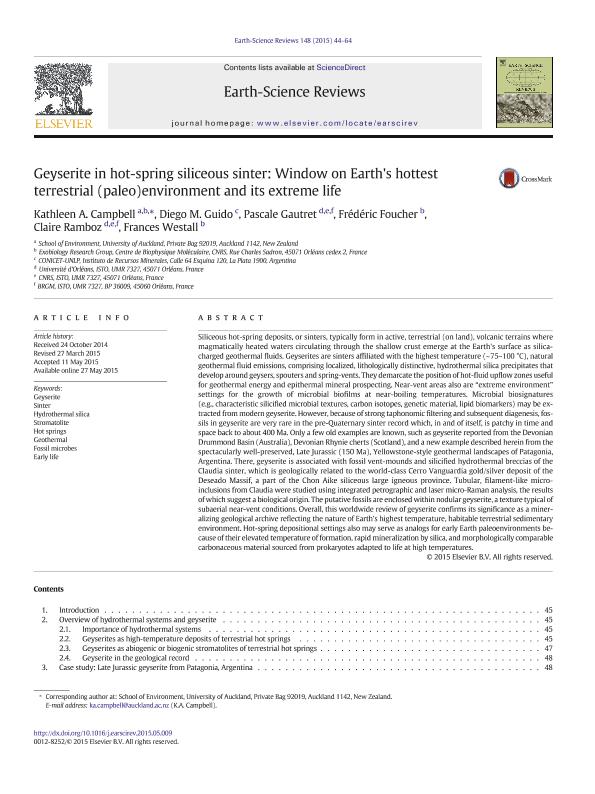Mostrar el registro sencillo del ítem
dc.contributor.author
Campbell, Kathleen A.
dc.contributor.author
Guido, Diego Martin

dc.contributor.author
Gautret, Pascale
dc.contributor.author
Foucher, Frédéric
dc.contributor.author
Ramboz, Claire
dc.contributor.author
Westall, Frances
dc.date.available
2017-03-10T20:53:24Z
dc.date.issued
2015-09
dc.identifier.citation
Campbell, Kathleen A.; Guido, Diego Martin; Gautret, Pascale; Foucher, Frédéric; Ramboz, Claire; et al.; Geyserite in hot-spring siliceous sinter: window on Earth's hottest terrestrial (paleo)environment and its extreme life; Elsevier Science; Earth-science Reviews; 148; 9-2015; 44-64
dc.identifier.issn
0012-8252
dc.identifier.uri
http://hdl.handle.net/11336/13732
dc.description.abstract
Siliceous hot-spring deposits, or sinters, typically form in active, terrestrial (on land), volcanic terrains where magmatically heated waters circulating through the shallow crust emerge at the Earth's surface as silica-charged geothermal fluids. Geyserites are sinters affiliated with the highest temperature (~ 75–100 °C), natural geothermal fluid emissions, comprising localized, lithologically distinctive, hydrothermal silica precipitates that develop around geysers, spouters and spring-vents. They demarcate the position of hot-fluid upflow zones useful for geothermal energy and epithermal mineral prospecting. Near-vent areas also are “extreme environment” settings for the growth of microbial biofilms at near-boiling temperatures. Microbial biosignatures (e.g., characteristic silicified microbial textures, carbon isotopes, genetic material, lipid biomarkers) may be extracted from modern geyserite. However, because of strong taphonomic filtering and subsequent diagenesis, fossils in geyserite are very rare in the pre-Quaternary sinter record which, in and of itself, is patchy in time and space back to about 400 Ma. Only a few old examples are known, such as geyserite reported from the Devonian Drummond Basin (Australia), Devonian Rhynie cherts (Scotland), and a new example described herein from the spectacularly well-preserved, Late Jurassic (150 Ma), Yellowstone-style geothermal landscapes of Patagonia, Argentina. There, geyserite is associated with fossil vent-mounds and silicified hydrothermal breccias of the Claudia sinter, which is geologically related to the world-class Cerro Vanguardia gold/silver deposit of the Deseado Massif, a part of the Chon Aike siliceous large igneous province. Tubular, filament-like micro-inclusions from Claudia were studied using integrated petrographic and laser micro-Raman analysis, the results of which suggest a biological origin. The putative fossils are enclosed within nodular geyserite, a texture typical of subaerial near-vent conditions. Overall, this worldwide review of geyserite confirms its significance as a mineralizing geological archive reflecting the nature of Earth's highest temperature, habitable terrestrial sedimentary environment. Hot-spring depositional settings also may serve as analogs for early Earth paleoenvironments because of their elevated temperature of formation, rapid mineralization by silica, and morphologically comparable carbonaceous material sourced from prokaryotes adapted to life at high temperatures.
dc.format
application/pdf
dc.language.iso
eng
dc.publisher
Elsevier Science

dc.rights
info:eu-repo/semantics/openAccess
dc.rights.uri
https://creativecommons.org/licenses/by-nc-nd/2.5/ar/
dc.subject
Geyserite
dc.subject
Sinter
dc.subject
Hydrothermal Silica
dc.subject
Stromatolite
dc.subject
Hot Springs
dc.subject
Geothermal
dc.subject
Fossil Microbes
dc.subject
Early Life
dc.subject.classification
Geociencias multidisciplinaria

dc.subject.classification
Ciencias de la Tierra y relacionadas con el Medio Ambiente

dc.subject.classification
CIENCIAS NATURALES Y EXACTAS

dc.title
Geyserite in hot-spring siliceous sinter: window on Earth's hottest terrestrial (paleo)environment and its extreme life
dc.type
info:eu-repo/semantics/article
dc.type
info:ar-repo/semantics/artículo
dc.type
info:eu-repo/semantics/publishedVersion
dc.date.updated
2017-03-08T15:40:32Z
dc.journal.volume
148
dc.journal.pagination
44-64
dc.journal.pais
Países Bajos

dc.journal.ciudad
Amsterdam
dc.description.fil
Fil: Campbell, Kathleen A.. The University Of Auckland; Nueva Zelanda. Centre National de la Recherche Scientifique; Francia
dc.description.fil
Fil: Guido, Diego Martin. Universidad Nacional de La Plata. Facultad de Ciencias Naturales y Museo. Instituto de Recursos Minerales; Argentina. Consejo Nacional de Investigaciones Científicas y Técnicas; Argentina
dc.description.fil
Fil: Gautret, Pascale. Centre National de la Recherche Scientifique; Francia. Université d; Francia. Institut des Sciences de la Terre d; Francia
dc.description.fil
Fil: Foucher, Frédéric. Centre National de la Recherche Scientifique; Francia
dc.description.fil
Fil: Ramboz, Claire. Centre National de la Recherche Scientifique; Francia. Université d; Francia. Institut des Sciences de la Terre d; Francia
dc.description.fil
Fil: Westall, Frances. Centre National de la Recherche Scientifique; Francia
dc.journal.title
Earth-science Reviews

dc.relation.alternativeid
info:eu-repo/semantics/altIdentifier/doi/http://dx.doi.org/10.1016/j.earscirev.2015.05.009
dc.relation.alternativeid
info:eu-repo/semantics/altIdentifier/url/http://www.sciencedirect.com/science/article/pii/S0012825215000926
Archivos asociados
